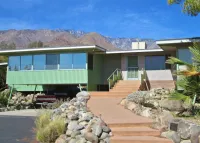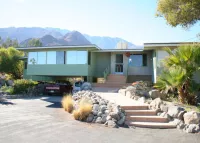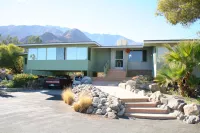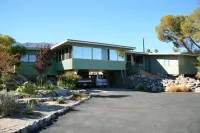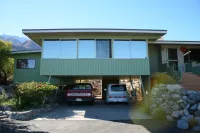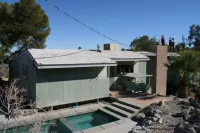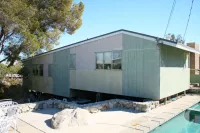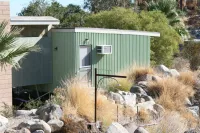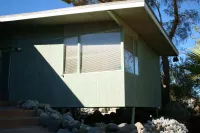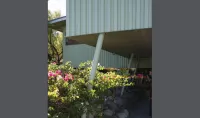Share what you know,
and discover more.
Share what you know,
and discover more.
Dec 20, 2021
Dec 20, 2021
651 West Vía Escuela, Palm Springs, CA, USA
Posted Date
Dec 20, 2021
Historical Record Date
Dec 20, 2021
Source Name
ModTraveler
Delete Story
Are you sure you want to delete this story?
Sep 28, 2015
Sep 28, 2015
651 West Vía Escuela, Palm Springs, CA, USA
Posted Date
Dec 20, 2021
Historical Record Date
Sep 28, 2015
Source Name
United States Department of the Interior - National Park Service
Delete Story
Are you sure you want to delete this story?
Aug 13, 2015
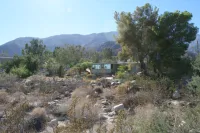
-

- Dave D
National Register of Historic Places - Summary
Summary Paragraph The Carey House of 1956 is located in the northwestern portion of Palm Springs. This single-family residence reflects Albert Frey’s desert modern design philosophy by appearing to float above its sloped and boulder-strewn desert landscape. Modest in size, the wood-framed house features a low-pitched shed roof, asbestos-cement board cladding, and steel posts to raise the house above the ground. It is in excellent condition and exhibits a high level of integrity. Narrative Description With the Carey House, Albert Frey applied lessons learned from the house he designed the previous year, 1955, for Raymond Cree, known as Cree House II. Like Cree House II, the single-family Carey House is perched on a slope covered in boulders. In this case, almost the entirety of the wood-framed house is raised above the ground on slender steel posts. Each post is angled inward for stability in the event of earthquakes. Only the concrete entry path and steps visually anchor the east-facing dwelling to the ground. The one-story house is irregular in plan and situated near the end of a road such that there are no immediate neighbors on all four sides. The one-acre parcel has been left in its natural state with boulders and native flora serving as landscaping. An adjacent unimproved one-acre parcel to the west is owned by the subject property owner, which adds to the site’s natural setting. In accommodating the rocky slope, the house visibly steps up the hillside as viewed from either side. The side-gabled roof covering the stepped composition consists of an extended downward sloping portion. Deep eaves shelter the house on east and west elevations. The dwelling’s exterior consists of industrial materials—asbestos cement board cladding fastened with exposed screws, and steel-framed fixed and casement windows—that require minimal maintenance. Asbestos cement boards of the window zone are colored differently than those of the wall zone to differentiate each area. Pilotis, slender, angled steel posts, support the southeast port of the house that shelters a two-car carport below. Property owners Vincent and Karen Pirozzi purchased the house from the Careys in 1978. Over the years the Pirozzis hired Albert Frey to modify the house. The area above the carport that had originally been an open deck was enclosed in 1983 by Frey to add more space to the living room. Nine years later, in 1992, a den designed by Frey was added to the southwest corner of the house. Asbestos cement board siding was no longer available for these modifications, so corrugated metal was used instead. Frey did not design the small lap pool at the rear of the dwelling that was added in 2006. As relates to integrity, the only modification visible from the street is the enclosed carport deck. The added den is mostly hidden from view because of its recessed location at the dwelling’s far southwest corner. Both alterations utilize corrugated metal siding, which is consistent in design, materials, and workmanship with the siding Frey incorporates in many of his buildings. The lap pool does not affect integrity because it is out of view behind the house. Despite the noted alteration on the publicly visible street façade, the Carey House is able to convey its architectural significance because the property retains the essential physical features associated with the work of Albert Frey. These features include deep overhangs, asbestos concrete board cladding, and slender steel pilotis. In addition, the design rejects applied ornamentation and historical references. The Carey House remains a single-family dwelling as relates to association, is at its original location, and the setting has been retained. Because of these factors, integrity of feeling also remains high. Statement of Significance Summary - The Carey House is eligible for the National Register of Historic Places under Criterion C at the local level of significance in the area of Architecture. The property embodies the distinctive characteristics of residential architecture associated with the modern movement as interpreted by Albert Frey for the desert environment of the Coachella Valley. In addition, the property meets The Architecture of Albert Frey Multiple Property Submission registration requirements for single-family residences in association with the historic context “Desert Modern Design in the Coachella Valley, 1934-1965.” The period of significance corresponds with the building’s date of construction, 1956. Narrative Statement of Significance - The subject property was designed by architect Albert Frey for Laura R. Carey in 1956. The original building permit indicates that the five-room dwelling cost approximately $25,000 to construct. Located on a rocky slope far from other dwellings, the Carey House was designed specifically for its local environment, floating above the desert boulders as it steps down the hillside. Clad in industrial materials, it requires little maintenance. The house exhibits such tenets of the modern movement as an absence of applied ornamentation and a rejection of historical references; indeed, the dwelling’s form follows its function. The Carey House exemplifies the distinctive characteristics of single-family residences associated with architect Albert Frey. The importance of the house and its significance within the “Desert modern design in the Coachella Valley 1934-1965” historic context are presented in the Multiple Property Documentation Form. The house is a key example of the single-family residence property type that maintains sufficient integrity to convey its significance as a readily identifiable work of master architect Albert Frey. The property meets National Register Criterion C because it embodies the distinctive characteristics of residential architecture associated with Albert Frey and is the work of a master architect.
National Register of Historic Places - Summary
Summary Paragraph The Carey House of 1956 is located in the northwestern portion of Palm Springs. This single-family residence reflects Albert Frey’s desert modern design philosophy by appearing to float above its sloped and boulder-strewn desert landscape. Modest in size, the wood-framed house features a low-pitched shed roof, asbestos-cement board cladding, and steel posts to raise the house above the ground. It is in excellent condition and exhibits a high level of integrity. Narrative Description With the Carey House, Albert Frey applied lessons learned from the house he designed the previous year, 1955, for Raymond Cree, known as Cree House II. Like Cree House II, the single-family Carey House is perched on a slope covered in boulders. In this case, almost the entirety of the wood-framed house is raised above the ground on slender steel posts. Each post is angled inward for stability in the event of earthquakes. Only the concrete entry path and steps visually anchor the east-facing dwelling to the ground. The one-story house is irregular in plan and situated near the end of a road such that there are no immediate neighbors on all four sides. The one-acre parcel has been left in its natural state with boulders and native flora serving as landscaping. An adjacent unimproved one-acre parcel to the west is owned by the subject property owner, which adds to the site’s natural setting. In accommodating the rocky slope, the house visibly steps up the hillside as viewed from either side. The side-gabled roof covering the stepped composition consists of an extended downward sloping portion. Deep eaves shelter the house on east and west elevations. The dwelling’s exterior consists of industrial materials—asbestos cement board cladding fastened with exposed screws, and steel-framed fixed and casement windows—that require minimal maintenance. Asbestos cement boards of the window zone are colored differently than those of the wall zone to differentiate each area. Pilotis, slender, angled steel posts, support the southeast port of the house that shelters a two-car carport below. Property owners Vincent and Karen Pirozzi purchased the house from the Careys in 1978. Over the years the Pirozzis hired Albert Frey to modify the house. The area above the carport that had originally been an open deck was enclosed in 1983 by Frey to add more space to the living room. Nine years later, in 1992, a den designed by Frey was added to the southwest corner of the house. Asbestos cement board siding was no longer available for these modifications, so corrugated metal was used instead. Frey did not design the small lap pool at the rear of the dwelling that was added in 2006. As relates to integrity, the only modification visible from the street is the enclosed carport deck. The added den is mostly hidden from view because of its recessed location at the dwelling’s far southwest corner. Both alterations utilize corrugated metal siding, which is consistent in design, materials, and workmanship with the siding Frey incorporates in many of his buildings. The lap pool does not affect integrity because it is out of view behind the house. Despite the noted alteration on the publicly visible street façade, the Carey House is able to convey its architectural significance because the property retains the essential physical features associated with the work of Albert Frey. These features include deep overhangs, asbestos concrete board cladding, and slender steel pilotis. In addition, the design rejects applied ornamentation and historical references. The Carey House remains a single-family dwelling as relates to association, is at its original location, and the setting has been retained. Because of these factors, integrity of feeling also remains high. Statement of Significance Summary - The Carey House is eligible for the National Register of Historic Places under Criterion C at the local level of significance in the area of Architecture. The property embodies the distinctive characteristics of residential architecture associated with the modern movement as interpreted by Albert Frey for the desert environment of the Coachella Valley. In addition, the property meets The Architecture of Albert Frey Multiple Property Submission registration requirements for single-family residences in association with the historic context “Desert Modern Design in the Coachella Valley, 1934-1965.” The period of significance corresponds with the building’s date of construction, 1956. Narrative Statement of Significance - The subject property was designed by architect Albert Frey for Laura R. Carey in 1956. The original building permit indicates that the five-room dwelling cost approximately $25,000 to construct. Located on a rocky slope far from other dwellings, the Carey House was designed specifically for its local environment, floating above the desert boulders as it steps down the hillside. Clad in industrial materials, it requires little maintenance. The house exhibits such tenets of the modern movement as an absence of applied ornamentation and a rejection of historical references; indeed, the dwelling’s form follows its function. The Carey House exemplifies the distinctive characteristics of single-family residences associated with architect Albert Frey. The importance of the house and its significance within the “Desert modern design in the Coachella Valley 1934-1965” historic context are presented in the Multiple Property Documentation Form. The house is a key example of the single-family residence property type that maintains sufficient integrity to convey its significance as a readily identifiable work of master architect Albert Frey. The property meets National Register Criterion C because it embodies the distinctive characteristics of residential architecture associated with Albert Frey and is the work of a master architect.
Aug 13, 2015
National Register of Historic Places - Summary
Summary ParagraphThe Carey House of 1956 is located in the northwestern portion of Palm Springs. This single-family residence reflects Albert Frey’s desert modern design philosophy by appearing to float above its sloped and boulder-strewn desert landscape. Modest in size, the wood-framed house features a low-pitched shed roof, asbestos-cement board cladding, and steel posts to raise the house above the ground. It is in excellent condition and exhibits a high level of integrity.
Narrative Description
With the Carey House, Albert Frey applied lessons learned from the house he designed the previous year, 1955, for Raymond Cree, known as Cree House II. Like Cree House II, the single-family Carey House is perched on a slope covered in boulders. In this case, almost the entirety of the wood-framed house is raised above the ground on slender steel posts. Each post is angled inward for stability in the event of earthquakes. Only the concrete entry path and steps visually anchor the east-facing dwelling to the ground.
The one-story house is irregular in plan and situated near the end of a road such that there are no immediate neighbors on all four sides. The one-acre parcel has been left in its natural state with boulders and native flora serving as landscaping. An adjacent unimproved one-acre parcel to the west is owned by the subject property owner, which adds to the site’s natural setting. In accommodating the rocky slope, the house visibly steps up the hillside as viewed from either side. The side-gabled roof covering the stepped composition consists of an extended downward sloping portion. Deep eaves shelter the house on east and west elevations. The dwelling’s exterior consists of industrial materials—asbestos cement board cladding fastened with exposed screws, and steel-framed fixed and casement windows—that require minimal maintenance. Asbestos cement boards of the window zone are colored differently than those of the wall zone to differentiate each area. Pilotis, slender, angled steel posts, support the southeast port of the house that shelters a two-car carport below.
Property owners Vincent and Karen Pirozzi purchased the house from the Careys in 1978. Over the years the Pirozzis hired Albert Frey to modify the house. The area above the carport that had originally been an open deck was enclosed in 1983 by Frey to add more space to the living room. Nine years later, in 1992, a den designed by Frey was added to the southwest corner of the house. Asbestos cement board siding was no longer available for these modifications, so corrugated metal was used instead. Frey did not design the small lap pool at the rear of the dwelling that was added in 2006.
As relates to integrity, the only modification visible from the street is the enclosed carport deck. The added den is mostly hidden from view because of its recessed location at the dwelling’s far southwest corner. Both alterations utilize corrugated metal siding, which is consistent in design, materials, and workmanship with the siding Frey incorporates in many of his buildings. The lap pool does not affect integrity because it is out of view behind the house.
Despite the noted alteration on the publicly visible street façade, the Carey House is able to convey its architectural significance because the property retains the essential physical features associated with the work of Albert Frey. These features include deep overhangs, asbestos concrete board cladding, and slender steel pilotis. In addition, the design rejects applied ornamentation and historical references. The Carey House remains a single-family dwelling as relates to association, is at its original location, and the setting has been retained. Because of these factors, integrity of feeling also remains high.
Statement of Significance Summary - The Carey House is eligible for the National Register of Historic Places under Criterion C at the local level of significance in the area of Architecture. The property embodies the distinctive characteristics of residential architecture associated with the modern movement as interpreted by Albert Frey for the desert environment of the Coachella Valley. In addition, the property meets The Architecture of Albert Frey Multiple Property Submission registration requirements for single-family residences in association with the historic context “Desert Modern Design in the Coachella Valley, 1934-1965.” The period of significance corresponds with the building’s date of construction, 1956.
Narrative Statement of Significance - The subject property was designed by architect Albert Frey for Laura R. Carey in 1956. The original building permit indicates that the five-room dwelling cost approximately $25,000 to construct. Located on a rocky slope far from other dwellings, the Carey House was designed specifically for its local environment, floating above the desert boulders as it steps down the hillside. Clad in industrial materials, it requires little maintenance. The house exhibits such tenets of the modern movement as an absence of applied ornamentation and a rejection of historical references; indeed, the dwelling’s form follows its function.
The Carey House exemplifies the distinctive characteristics of single-family residences associated with architect Albert Frey. The importance of the house and its significance within the “Desert modern design in the Coachella Valley 1934-1965” historic context are presented in the Multiple Property Documentation Form. The house is a key example of the single-family residence property type that maintains sufficient integrity to convey its significance as a readily identifiable work of master architect Albert Frey. The property meets National Register Criterion C because it embodies the distinctive characteristics of residential architecture associated with Albert Frey and is the work of a master architect.
Posted Date
Dec 20, 2021
Historical Record Date
Aug 13, 2015
Source Name
United States Department of the Interior - National Park Service
Delete Story
Are you sure you want to delete this story?


